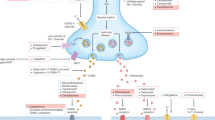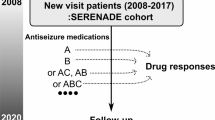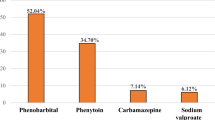Abstract
The incidence of new-onset epilepsy is high among elderly patients. Seizures can present differently to and with more subtle semiology than those in younger adults. This difference in presentation frequently poses a diagnostic challenge. Elderly patients also often have comorbidities, are usually on multiple medications that can interact, have altered medication pharmacokinetics, and tend to be particularly sensitive to adverse effects of medication. Seizures in the elderly tend, however, to respond better to antiepileptic drugs than those in younger individuals, and can often be appropriately controlled with monotherapy. After the diagnosis of epilepsy is confirmed, treatment should be started with a single medication at a low dose, with subsequent gradual upward titration until seizures are controlled. First-generation antiepileptic drugs should be avoided in the elderly in view of poor tolerability. A large trial has shown that lamotrigine and gabapentin are better tolerated than carbamazepine. In elderly patients whose seizures remain uncontrolled on antiepileptic medications, surgery can be considered if excellent results are predicted and the risks are low.
Key Points
-
The incidence of epilepsy increases with age in people over 50 years old
-
Cerebrovascular disease is the most common identifiable cause of epilepsy in elderly individuals
-
Seizure presentation can differ between elderly and younger populations, and seizures are often misdiagnosed in elderly patients
-
Elderly people are particularly prone to the side effects of antiepileptic drugs, owing to age-related pharmacokinetic changes, comorbidities and polytherapy
-
Epilepsy in the elderly is best treated with monotherapy of newer antiepileptic drugs with no evidence of interactions with other drugs
This is a preview of subscription content, access via your institution
Access options
Subscribe to this journal
Receive 12 print issues and online access
$189.00 per year
only $15.75 per issue
Buy this article
- Purchase on SpringerLink
- Instant access to full article PDF
Prices may be subject to local taxes which are calculated during checkout
Similar content being viewed by others
References
Hauser, W. A., Annegers, J. F. & Kurland, L. T. Prevalence of epilepsy in Rochester, Minnesota: 1940–1980. Epilepsia 32, 429–445 (1991).
Olafsson, E. & Hauser, W. A. Prevalence of epilepsy in rural Iceland: a population-based study. Epilepsia 40, 1529–1534 (1999).
Tinuper, P. et al. Partial epilepsy of long duration: changing semiology with age. Epilepsia 37, 162–164 (1996).
Fernandez-Torre, J. L. & Diaz-Castroverde, A. G. Non-convulsive status epilepticus in elderly individuals: report of four representative cases. Age Ageing 33, 78–81 (2004).
Hauser, W. A., Annegers, J. F. & Kurland, L. T. Incidence of epilepsy and unprovoked seizures in Rochester, Minnesota: 1935–1984. Epilepsia 34, 453–468 (1993).
Rowan, A. J. et al. New onset geriatric epilepsy: a randomized study of gabapentin, lamotrigine, and carbamazepine. Neurology 64, 1868–1873 (2005).
Kellinghaus, C., Loddenkemper, T., Dinner, D. S., Lachhwani, D. & Luders, H. O. Seizure semiology in the elderly: a video analysis. Epilepsia 45, 263–267 (2004).
Ramsay, R. E., Rowan, A. J. & Pryor, F. M. Special considerations in treating the elderly patient with epilepsy. Neurology 62 (Suppl. 2), S24–S29 (2004).
Ramsay, R. E. & Pryor, F. Epilepsy in the elderly. Neurology 55 (Suppl. 1), S9–S14 (2000).
Thomas, P., Beaumanoir, A., Genton, P., Dolisi, C. & Chatel, M. 'De novo' absence status of late onset: report of 11 cases. Neurology 42, 104–110 (1992).
Hauser, W. A. Seizure disorders: the changes with age. Epilepsia 33 (Suppl. 4), S6–S14 (1992).
Dhanuka, A. K., Misra, U. K. & Kalita, J. Seizures after stroke: a prospective clinical study. Neurol. India 49, 33–36 (2001).
Bladin, C. F. et al. Seizures after stroke: a prospective multicenter study. Arch. Neurol. 57, 1617–1622 (2000).
Hauser, W. A., Morris, M. L., Heston, L. L. & Anderson, V. E. Seizures and myoclonus in patients with Alzheimer's disease. Neurology 36, 1226–1230 (1986).
Rao, S. C., Dove, G., Cascino, G. D. & Petersen, R. C. Recurrent seizures in patients with dementia: frequency, seizure types, and treatment outcome. Epilepsy Behav. 14, 118–120 (2008).
Hesdorffer, D. C., Hauser, W. A., Annegers, J. F. & Cascino, G. Major depression is a risk factor for seizures in older adults. Ann. Neurol. 47, 246–249 (2000).
Ng, S. K., Hauser, W. A., Brust, J. C. & Susser, M. Hypertension and the risk of new-onset unprovoked seizures. Neurology 43, 425–428 (1993).
Hesdorffer, D. C., Hauser, W. A., Annegers, J. F. & Rocca, W. A. Severe, uncontrolled hypertension and adult-onset seizures: a case-control study in Rochester, Minnesota. Epilepsia 37, 736–741 (1996).
Chihorek, A. M., Abou-Khalil, B. & Malow, B. A. Obstructive sleep apnea is associated with seizure occurrence in older adults with epilepsy. Neurology 69, 1823–1827 (2007).
Drury, I. & Beydoun, A. Interictal epileptiform activity in elderly patients with epilepsy. Electroencephalogr. Clin. Neurophysiol. 106, 369–373 (1998).
Drury, I. et al. Value of inpatient diagnostic CCTV–EEG monitoring in the elderly. Epilepsia 40, 1100–1102 (1999).
Fisher, R. S. & Leppik, I. Debate: When does a seizure imply epilepsy? Epilepsia 49 (Suppl. 9), 7–12 (2008).
Battino, D. et al. Serum carbamazepine concentrations in elderly patients: a case-matched pharmacokinetic evaluation based on therapeutic drug monitoring data. Epilepsia 44, 923–929 (2003).
Fattore, C. et al. The influence of old age and enzyme inducing comedication on the pharmacokinetics of valproic acid at steady-state: a case-matched evaluation based on therapeutic drug monitoring data. Epilepsy Res. 70, 153–160 (2006).
Willmore, L. J. The effect of age on pharmacokinetics of antiepileptic drugs. Epilepsia 36 (Suppl. 5), S14–S21 (1995).
Ucar, M. et al. Carbamazepine markedly reduces serum concentrations of simvastatin and simvastatin acid. Eur. J. Clin. Pharmacol. 59, 879–882 (2004).
Nappi, J. M. Warfarin and phenytoin interaction. Ann. Intern. Med. 90, 852 (1979).
Grimsley, S. R., Jann, M. W., Carter, J. G., D'Mello, A. P. & D'Souza, M. J. Increased carbamazepine plasma concentrations after fluoxetine coadministration. Clin. Pharmacol. Ther. 50, 10–15 (1991).
Samuels, N., Finkelstein, Y., Singer, S. R. & Oberbaum, M. Herbal medicine and epilepsy: proconvulsive effects and interactions with antiepileptic drugs. Epilepsia 49, 373–380 (2008).
Pack, A. M. & Walczak, T. S. Bone health in women with epilepsy: clinical features and potential mechanisms. Int. Rev. Neurobiol. 83, 305–328 (2008).
Souverein, P. C., Webb, D. J., Weil, J. G., Van Staa, T. P. & Egberts, A. C. Use of antiepileptic drugs and risk of fractures: case-control study among patients with epilepsy. Neurology 66, 1318–1324 (2006).
Leppik, I. E. Epilepsy in the elderly. Epilepsia 47 (Suppl. 1), 65–70 (2006).
Lackner, T. E., Cloyd, J. C., Thomas, L. W. & Leppik, I. E. Antiepileptic drug use in nursing home residents: effect of age, gender, and comedication on patterns of use. Epilepsia 39, 1083–1087 (1998).
Choudhry, N. K., Setoguchi, S., Levin, R., Winkelmayer, W. C. & Shrank, W. H. Trends in adherence to secondary prevention medications in elderly post-myocardial infarction patients. Pharmacoepidemiol. Drug Saf. 17, 1189–1196 (2008).
Berecki-Gisolf, J., Hockey, R. & Dobson, A. Adherence to bisphosphonate treatment by elderly women. Menopause 15, 984–990 (2008).
Faught, E., Duh, M. S., Weiner, J. R., Guerin, A. & Cunnington, M. C. Nonadherence to antiepileptic drugs and increased mortality: findings from the RANSOM Study. Neurology 71, 1572–1578 (2008).
Mattson, R. H. et al. Comparison of carbamazepine, phenobarbital, phenytoin, and primidone in partial and secondarily generalized tonic–clonic seizures. N. Engl. J. Med. 313, 145–151 (1985).
Mattson, R. H., Cramer, J. A. & Collins, J. F. A comparison of valproate with carbamazepine for the treatment of complex partial seizures and secondarily generalized tonic–clonic seizures in adults. The Department of Veterans Affairs Epilepsy Cooperative Study No. 264 Group. N. Engl. J. Med. 327, 765–771 (1992).
Brodie, M. J., Overstall, P. W. & Giorgi, L. Multicentre, double-blind, randomised comparison between lamotrigine and carbamazepine in elderly patients with newly diagnosed epilepsy. The UK Lamotrigine Elderly Study Group. Epilepsy Res. 37, 81–87 (1999).
Marson, A. G. et al. The SANAD study of effectiveness of carbamazepine, gabapentin, lamotrigine, oxcarbazepine, or topiramate for treatment of partial epilepsy: an unblinded randomised controlled trial. Lancet 369, 1000–1015 (2007).
Saetre, E., Perucca, E., Isojarvi, J., Gjerstad, L. & LAM 40089 Study Group. An international multicenter randomized double-blind controlled trial of lamotrigine and sustained-release carbamazepine in the treatment of newly diagnosed epilepsy in the elderly. Epilepsia 48, 1292–1302 (2007).
Bauer, L. A. & Blouin, R. A. Age and phenytoin kinetics in adult epileptics. Clin. Pharmacol. Ther. 31, 301–304 (1982).
Birnbaum, A. et al. Variability of total phenytoin serum concentrations within elderly nursing home residents. Neurology 60, 555–559 (2003).
Garrard, J., Harms, S. L., Eberly, L. E. & Leppik, I. E. Use of antiepileptic medications in nursing homes. Int. Rev. Neurobiol. 81, 165–182 (2007).
Mintzer, S. et al. Effects of antiepileptic drugs on lipids, homocysteine, and C-reactive protein. Ann. Neurol. 65, 448–456 (2009).
Perucca, E. et al. Pharmacokinetics of valproic acid in the elderly. Br. J. Clin. Pharmacol. 17, 665–669 (1984).
Armon, C. et al. Reversible parkinsonism and cognitive impairment with chronic valproate use. Neurology 47, 626–635 (1996).
Jamora, D., Lim, S. H., Pan, A., Tan, L. & Tan, E. K. Valproate-induced parkinsonism in epilepsy patients. Mov. Disord. 22, 130–133 (2007).
Craig, I. & Tallis, R. Impact of valproate and phenytoin on cognitive function in elderly patients: results of a single-blind randomized comparative study. Epilepsia 35, 381–390 (1994).
Ortenzi, A., Paggi, A., Foschi, N., Sabbatini, D. & Pistoli, E. Oxcarbazepine and adverse events: impact of age, dosage, metabolite serum concentrations and concomitant antiepileptic therapy. Funct. Neurol. 23, 97–100 (2008).
Dong, X., Leppik, I. E., White, J. & Rarick, J. Hyponatremia from oxcarbazepine and carbamazepine. Neurology 65, 1976–1978 (2005).
Nielsen, O. A., Johannessen, A. C. & Bardrum, B. Oxcarbazepine-induced hyponatremia, a cross-sectional study. Epilepsy Res. 2, 269–271 (1988).
Kutluay, E., McCague, K., D'Souza, J. & Beydoun, A. Safety and tolerability of oxcarbazepine in elderly patients with epilepsy. Epilepsy Behav. 4, 175–180 (2003).
Dogan, E. A., Usta, B. E., Bilgen, R., Senol, Y. & Aktekin, B. Efficacy, tolerability, and side effects of oxcarbazepine monotherapy: a prospective study in adult and elderly patients with newly diagnosed partial epilepsy. Epilepsy Behav. 13, 156–161 (2008).
French, J. A. et al. Efficacy and tolerability of the new antiepileptic drugs I: treatment of new onset epilepsy: report of the Therapeutics and Technology Assessment Subcommittee and Quality Standards Subcommittee of the American Academy of Neurology and the American Epilepsy Society. Neurology 62, 1252–1260 (2004).
Blum, D. et al. Cognitive effects of lamotrigine compared with topiramate in patients with epilepsy. Neurology 67, 400–406 (2006).
Meador, K. J. et al. Cognitive and behavioral effects of lamotrigine and topiramate in healthy volunteers. Neurology 64, 2108–2114 (2005).
Lee, S. et al. The effects of adjunctive topiramate on cognitive function in patients with epilepsy. Epilepsia 44, 339–347 (2003).
Ramsay, R. E. et al. Topiramate in older patients with partial-onset seizures: a pilot double-blind, dose-comparison study. Epilepsia 49, 1180–1185 (2008).
Groselj, J. et al. Experience with topiramate monotherapy in elderly patients with recent-onset epilepsy. Acta Neurol. Scand. 112, 144–150 (2005).
Brodie, M. J., Perucca, E., Ryvlin, P., Ben-Menachem, E. & Meencke, H. J. Comparison of levetiracetam and controlled-release carbamazepine in newly diagnosed epilepsy. Neurology 68, 402–408 (2007).
Alsaadi, T. M., Koopmans, S., Apperson, M. & Farias, S. Levetiracetam monotherapy for elderly patients with epilepsy. Seizure 13, 58–60 (2004).
Garcia-Escriva, A. & Lopez-Hernandez, N. The use of levetiracetam in monotherapy in post-stroke seizures in the elderly population [Spanish]. Rev. Neurol. 45, 523–525 (2007).
Ferrendelli, J. A. et al. Use of levetiracetam in a population of patients aged 65 years and older: a subset analysis of the KEEPER trial. Epilepsy Behav. 4, 702–709 (2003).
Cramer, J. A., Leppik, I. E., Rue, K. D., Edrich, P. & Kramer, G. Tolerability of levetiracetam in elderly patients with CNS disorders. Epilepsy Res. 56, 135–145 (2003).
Pedersen, B. Epilepsy in the elderly: the use of tiagabine. Epilepsia 42 (Suppl. 3), 52–54 (2001).
Beghi, E. et al. Adjunctive therapy versus alternative monotherapy in patients with partial epilepsy failing on a single drug: a multicentre, randomised, pragmatic controlled trial. Epilepsy Res. 57, 1–13 (2003).
Patsalos, P. N. et al. Antiepileptic drugs--best practice guidelines for therapeutic drug monitoring: a position paper by the subcommission on therapeutic drug monitoring, ILAE Commission on Therapeutic Strategies. Epilepsia 49, 1239–1276 (2008).
Cascino, G. D., Sharbrough, F. W., Hirschorn, K. A. & Marsh, W. R. Surgery for focal epilepsy in the older patient. Neurology 41, 1415–1417 (1991).
Sirven, J. I., Malamut, B. L., O'Connor, M. J. & Sperling, M. R. Temporal lobectomy outcome in older versus younger adults. Neurology 54, 2166–2170 (2000).
Grivas, A. et al. Surgical treatment for refractory temporal lobe epilepsy in the elderly: seizure outcome and neuropsychological sequels compared with a younger cohort. Epilepsia 47, 1364–1372 (2006).
Boling, W. et al. Surgery for temporal lobe epilepsy in older patients. J. Neurosurg. 95, 242–248 (2001).
Acosta, I., Vale, F., Tatum, W. O. 4th & Benbadis, S. R. Epilepsy surgery after age 60. Epilepsy Behav. 12, 324–325 (2008).
Sirven, J. I. et al. Vagus nerve stimulation therapy for epilepsy in older adults. Neurology 54, 1179–1182 (2000).
Malow, B. A., Edwards, J., Marzec, M., Sagher, O. & Fromes, G. Effects of vagus nerve stimulation on respiration during sleep: a pilot study. Neurology 55, 1450–1454 (2000).
Baker, G. A. et al. The quality of life of older people with epilepsy: findings from a UK community study. Seizure 10, 92–99 (2001).
Laccheo, I. et al. Assessment of quality of life among the elderly with epilepsy. Epilepsy Behav. 12, 257–261 (2008).
Devinsky, O. Quality of life in the elderly with epilepsy. Epilepsy Behav. 6, 1–3 (2005).
Haut, S. R., Katz, M., Masur, J. & Lipton, R. B. Seizures in the elderly: impact on mental status, mood, and sleep. Epilepsy Behav. 14, 540–544 (2009).
Lempert, T., Bauer, M. & Schmidt, D. Syncope: a videometric analysis of 56 episodes of transient cerebral hypoxia. Ann. Neurol. 36, 233–237 (1994).
Quinette, P. et al. What does transient global amnesia really mean? Review of the literature and thorough study of 142 cases. Brain 129, 1640–1658 (2006).
Malow, B. A. Paroxysmal events in sleep. J. Clin. Neurophysiol. 19, 522–534 (2002).
Kellinghaus, C., Loddenkemper, T., Dinner, D. S., Lachhwani, D. & Luders, H. O. Non-epileptic seizures of the elderly. J. Neurol. 251, 704–709 (2004).
Gidal, B. E. Drug absorption in the elderly: biopharmaceutical considerations for the antiepileptic drugs. Epilepsy Res. 68 (Suppl. 1), S65–S69 (2006).
Jetter, G. M. & Cavazos, J. E. Epilepsy in the elderly. Semin. Neurol. 28, 336–341 (2008).
Hachad, H., Ragueneau-Majlessi, I. & Levy, R. H. New antiepileptic drugs: review on drug interactions. Ther. Drug Monit. 24, 91–103 (2002).
Levy, R. H. & Collins, C. Risk and predictability of drug interactions in the elderly. Int. Rev. Neurobiol. 81, 235–251 (2007).
Author information
Authors and Affiliations
Ethics declarations
Competing interests
The authors declare no competing financial interests.
Rights and permissions
About this article
Cite this article
Arain, A., Abou-Khalil, B. Management of new-onset epilepsy in the elderly. Nat Rev Neurol 5, 363–371 (2009). https://doi.org/10.1038/nrneurol.2009.74
Issue date:
DOI: https://doi.org/10.1038/nrneurol.2009.74
This article is cited by
-
Semiology of epileptic seizures in old age and the differential diagnosis – English Version
Zeitschrift für Epileptologie (2022)
-
Semiologie epileptischer Anfälle im Alter und ihre Differenzialdiagnose
Zeitschrift für Epileptologie (2022)
-
Comparative effectiveness of levetiracetam, valproate and carbamazepine among elderly patients with newly diagnosed epilepsy: subgroup analysis of the randomized, unblinded KOMET study
BMC Neurology (2016)
-
Migraine, Stroke and Epilepsy: Underlying and Interrelated Causes, Diagnosis and Treatment
Current Treatment Options in Cardiovascular Medicine (2013)



